This semester I’m working as the Student Podcast Fellow for the Shi Institute’s Podcast: “Upstate Anecdotes”. I’ve never done anything with podcasting, so I’m super excited to learn the ins and outs of audio storytelling while delivering stories about lesser known sociological and ecological issues around Greenville.
The first project topic I will be researching is the development of Unity Park in Greenville. Unity Park is a 60 ace park being developed west of downtown Greenville, encompassing Mayberry Park and the former Meadowbrook Park. The park is part of the city’s strategic mission to balance Greenville’s downtown development with ample green space, which includes a comprehensive environmental management plan to ensure the park does not interfere with biodiversity and ecosystem processes of the area.
The major environmental initiatives contacts and other stakeholders are pursing involves river restoration and tree planting. Harper General Contractors, the major constructing firm involved in the park’s development, are removing invasive tree species from Reedy River Bank and replacing with native vegetation. Trees on the bank of the Reedy river currently are mostly non-native species- distributed by birds and other animals involved in distributing their seeds. These non-native tees are preventing natural tees, like oaks, magnolias, cede, and sycamore trees, from prospering and participating in regulating the natural riparian ecosystem. The city has also made a commitment that for every tree removed, two or three will be planted. Having more trees along the bank will also prevent the possibility of bank failure, helping to maintain the aesthetic of the park while protecting species that live in the river.
Some environmental enhancements are also being built for practical purposes of storm protection. Designers are creating a drainage system to reduce floodwaters in the park and surrounding neighborhood of Southernside. The city is constructing landscaped depressions that will be filled with sandy soil and plants to filter runoff before it reaches the river in order to reduce the bank from eroding, improve water quality, and overall recharges the water table. Benches built around the riverbank will also create more surface area for water flow during flood events. The park is also developing the Swamp Rabbit Tail to extend its connectivity throughout the park to provide access from the park into downtown area and back.
The park is set to open in spring of 2022, and I know that I am excited for what the park will be. I love exploring the natural areas around Greenville, maybe this park will add to my inventory of favorite spots!
For more information, check out:
https://www.thestate.com/news/upstate/article247169171.html
https://gsabusiness.com/news/architecture/79758/
https://www.greenvilleonline.com/story/news/local/2018/05/17/greenville-new-park-unity-park-tower-pedestrian-bridge-trail-river/615648002/


